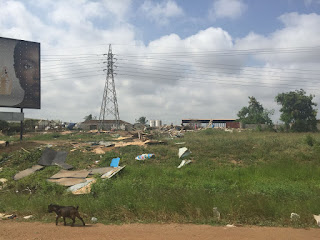So many people here work hard as street hawkers (peddlers) selling to those passing by in cars driving through intersections. The hours are long and they work in the hot sun and in the rain. It must be exhausting. Here we saw one woman who had stepped about five meters away from the street, lay down upon the rocky soil, and was taking a nap while her fellows continued to sell.
We have previously posted pictures of the housing used by the poor. Here is another example. This is on an overpass. In the foreground is the guardrail at the edge of the roadway. Next is the sidewalk that runs along the side of the overpass. On the far side of the sidewalk sits the metal fencing that runs along the outside of the sidewalk and marks where it ends and the overpass drops off to the street below. Beyond that are two billboards (the one on the left has blue poles, and the one on the right has red ones). In the center of the picture you can see someone's home. The roof is a white tarp spread over the sidewalk between the guardrail and the metal fencing. Various other items mark the sides. Here someone lives.
We haven't shown pictures of the middle-class yet. In this picture you see examples of their homes. This particular street is not paved at this time but the homes on either side are really quite nice. In my experience, middle-class neighborhoods usually do have paved streets. Notice that each home is built in a compound. The middle-class is growing here in Ghana, and you can see how these homes stretch into the distance. Ghana is in so many ways the jewel of Africa.
Then, of course, there are the wealthy. Here are some upper-class flats. There are also billboards around town advertising "Luxury Apartments" and even "Serviced Apartments" meaning they are like a hotel with maids, etc. taking care of your home for you. Very nice.
What is perhaps the greatest thing about Ghana, though, is it is a free country. Freedom of religion, freedom of speech, honest elections. These are not common blessings on the continent of Africa but Ghana helps to lead the way.
Elder Emfield

































